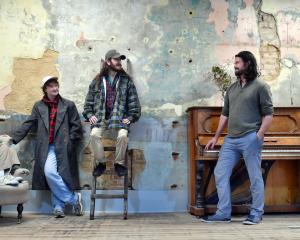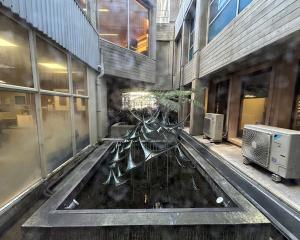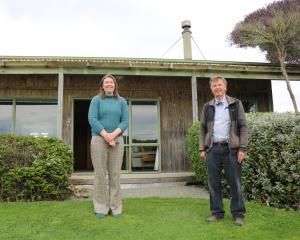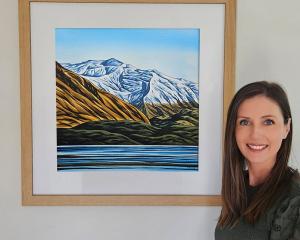Frances Hodgkins Fellow Zina Swanson's exhibition, ''No Need for Water'', opens at the Hocken Galleries tomorrow. Charmian Smith reports.
A year as Frances Hodgkins Fellow at the University of Otago has enabled Christchurch artist Zina Swanson to get back into a studio and make sculptures again. She and her partner, James Oram, also an artist, lost 10 years of work and all their equipment when three walls of their shared studio collapsed in the February 2011 earthquake.
''It's really amazing to have [a studio] again. I've found it got me thinking about sculptures and installations, whereas before I was getting caught up with just doing works on paper, and that's got a lot to do with having space to look at things in a different way,'' she said.
The couple were not in their studio when the earthquake happened and were not allowed to collect their works or equipment.
''I think the worst thing was thinking we would actually get things out, because it took so long for us to find out what the situation was with the building. We never actually saw it with our own eyes, we could never get close enough to it. We could only see it on pictures on the news and on the internet, so I'm not sure if that made it better or worse.''
Oram's works were still hanging on the remaining wall. One of Swanson's large sculptures, in a heavy crate that had just been delivered from the City Gallery, Wellington, was in the middle of the floor, and heavy chests of drawers held works on paper.
''I like to think that all my watercolours just blew out into the street and got washed off by the rain, which is a ridiculously romantic idea.''
The couple eventually moved to Auckland to start again, with the help of an arts council grant to restock with paper, pencils, paint and other tools and materials, she said.
''In some ways it was kind of refreshing. You have to look at it like that, otherwise you'd be too traumatised. It wasn't necessarily a clean slate, but it made me realise what it was I was interested in, and the works that seemed important. It clarified things for me.''
Initially she was interested visually in some of the structures used to prop up buildings, chimneys and walls, and incorporated them into some of her paintings, but a major theme over the past decade has been plants.
Her first plant work was a chair seat covered in rose thorns in her last year at the Canterbury School of Fine Arts, from which she graduated in 2004.
''It gives my works a finite life and I often play with things that are alive and things that are dead and things that change over a period of time,'' she said,Part-time work at the engineering and physical sciences library at Canterbury University enabled her to browse through forestry and botany books and she drew inspiration from some of the images.
''I don't necessarily understand the science of it, but there are certain things that end up informing the work. Even when it comes to the name: daisy means day's eye, so it opens and closes.''
Her 2009 exhibition ,''The risk of it all falling apart'' in the Physics Room, Christchurch, featured a giant chain of pressed daisies gathered from the banks of the Avon.
Another work featured a bed of stinging nettles. She had wanted to grow them from seed, but there had not been time, so she transplanted some from an organic vegetable farm.
''It was quite nice. Over the duration of the exhibition they seeded themselves, so small ones were growing and there were caterpillars and things, so it took on a life of its own which is something I quite like.''
At the biennial Scape in Christchurch earlier this year she organised a series of five performances in which volunteers, each with a different relationship to plants, were hypnotised by Reg Blackwood and asked to believe they could understand the thoughts of a plant that was near them.
''It was fascinating. I could only dictate the questions and whatever happened, happened. It could have been really boring but it wasn't. There were questions like 'what do you dream about?' The plant was a lancewood and the woman answered 'I dreamed I could fruit; it's very difficult for me to have fruit'. I've started a series of drawings from quotes taken from that. One image is of the lancewood covered in bananas and apples.''
The transcripts of the performances of this work, Can Anybody Hear Me? can be found on scapebiennial.org.nz.
For her Hocken exhibition, ''No Need for Water'', she has been inspired by reading a book written in the 1970s by Cleve Backster, an interrogation specialist for the CIA who used a polygraph lie detector.
''One day he decided to hook up his Dracaena plant to the polygraph to see what would happen. He had this thought of burning its leaf and supposedly the polygraphy went off the charts, so it sensed his intention to harm it.
''It's quite ridiculous but that's what I like about it. There are many people through history who have talked about plants having feelings and he's just one of them. I don't believe it, but it's quite interesting territory.''
One of the installations in her exhibition is inspired by Backster's experiment. A handsome Dracaena, to be revered and protected as opposed to Backster's thoughts of burning it, will be partly hidden behind a curtain made of 10,000 terracotta beads she has made that reference soil replacement material, she says.
Other installations include a ''water wall'', painted mats and other domestic furnishings, and works on paper.
However, she does not make the final decisions until she gets into the gallery the week before the exhibition opens, she said.
At the end of April, Swanson has an Apexart residency in New York for a month. Unlike other residencies, it does not require her to create works, but she has a programme of places to visit, events to attend, professionals to meet and classes to sit in on.
''It's very exciting. It's to experience new culture rather than make new work.''
She and Oram plan to stay in Dunedin for a while but think they may return to Auckland eventually.
See it
''No Need for Water'', an exhibition by Zina Swanson, 2013 Frances Hodgkins Fellow at the University of Otago, is showing at the Hocken Galleries from February 15 to April 5.













